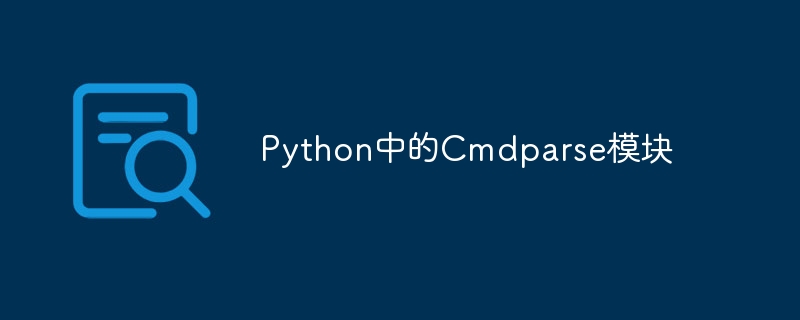

Python is a versatile and powerful programming language that has gained immense popularity due to its simplicity and extensive library support. Using Python, developers can create a wide range of applications, from web development to data analysis and automation. One of Python's standout features is its ability to easily handle the command line interface (CLI), thanks to modules like Cmdparse.
In this tutorial, we'll delve into the Cmdparse module and learn how to leverage its capabilities to create a powerful interactive CLI. We'll start with the basics, including the installation process and importing the module into a Python script. We'll then guide you through the process of defining commands and options and handling parameters efficiently.
To start using Cmdparse, we first need to install the module. Fortunately, the installation process is simple. In this tutorial, we will install Cmdparse using Python's package installer pip. Open a command prompt or terminal and execute the following command:
pip install cmdparse
This command will download and install the Cmdparse module from the Python Package Index (PyPI). Once the installation is complete, you can start using Cmdparse in your Python projects.
After installing Cmdparse, we need to import the module into a Python script to access its functionality. To import Cmdparse, add the following import statement at the beginning of the script:
import cmdparse
With this import statement, we can now use the Cmdparse module in our code. In the following sections of this article, we will explore the various features and capabilities of Cmdparse to build powerful command line interfaces.
Now that we have installed and imported Cmdparse, let’s dive into using Cmdparse to create a basic command line interface (CLI). This will lay the foundation for understanding the structure and components of a CLI built with Cmdparse.
In this example, let's create a simple CLI that allows users to greet each other. Open a text editor and create a new Python file. Import Cmdparse at the beginning of the file using the import statement we discussed earlier.
Next, define a class that inherits from `cmdparse.CmdParse` to create our CLI. We call it "GreetingCLI". In the class, define a method called "do_greet" which will handle the "greet" command. Here is a sample code snippet:
import cmdparse
class GreetingCLI(cmdparse.CmdParse):
def do_greet(self, argv):
print(f"Hello, {argv[0]}!")
if __name__ == '__main__':
cli = GreetingCLI()
cli.parse()
In this example, the "do_greet" method takes the parameter "argv", which represents the command line arguments passed to the "greet" command. Inside the method, we simply print a greeting message using the first parameter.
To execute the CLI, we create an instance of the `GreetingCLI` class and call its `parse()` method. This will parse the user's input and call the appropriate command handler.
Save the file with a ".py" extension and run it using the command prompt or terminal:
python filename.py
Now, in the command prompt, type "greet Prince" (replace "Prince" with any name you like) and press Enter key. The CLI will respond with "Hello, Prince!"
Congratulations! You have successfully created a basic CLI using Cmdparse. In the next part of this article, we'll explore how to define commands and options in more detail.
Command aliases allow us to define alternative names for existing commands, providing users with greater flexibility and convenience. To define an alias for a command, we can use the `add_alias()` method provided by Cmdparse.
Let’s continue with the previous GreetingCLI example. Suppose we want to add an alias for the "greet" command, allowing users to also use the "hello" command. Here is the updated code snippet:
import cmdparse
class GreetingCLI(cmdparse.CmdParse):
def do_greet(self, argv):
print(f"Hello, {argv[0]}!")
if __name__ == '__main__':
cli = GreetingCLI()
cli.add_alias('greet', 'hello')
# Adding alias for 'greet' command
cli.parse()
In this example, we add the line `cli.add_alias('greet', 'hello')` to the code. This line specifies that the "hello" command is an alias for the "greet" command. Now, users can use "greet" or "hello" to invoke the same functionality.
Another powerful feature of Cmdparse is the ability to create and manage command groups. Command groups allow us to categorize related commands under common group names, making the CLI more organized and easier to navigate. To create and manage command groups, we can use the add_group() method provided by Cmdparse.
Let's enhance the GreetingCLI by adding a command group called "greetings" and putting the "greet" command inside it. Here is the updated code snippet:
import cmdparse
class GreetingCLI(cmdparse.CmdParse):
def do_greet(self, argv):
print(f"Hello, {argv[0]}!")
if __name__ == '__main__':
cli = GreetingCLI()
greetings_group = cli.add_group('greetings') # Creating a command group
greetings_group.add_command('greet', cli.do_greet) # Adding 'greet' command to the group
cli.parse()
In this example, we create a command group named "greetings" using the "add_group()" method. We then add the "greet" command to the "greetings" group using the "add_command()" method. By organizing related commands into groups, we can provide a more logical structure for the CLI.
So far, we have successfully explored the advanced features of Cmdparse, including command aliases, command groups, and output customization.
In this tutorial, we delve into the world of the Cmdparse module in Python, which enables developers to create powerful interactive command line interfaces (CLI). We first install the module using pip and import it into our Python script. We provide examples for each step to ensure beginners can easily follow. We then used Cmdparse to create a basic CLI that allowed users to greet each other. Next, we explored advanced features like command aliases and command groups.
The above is the detailed content of Cmdparse module in Python. For more information, please follow other related articles on the PHP Chinese website!




